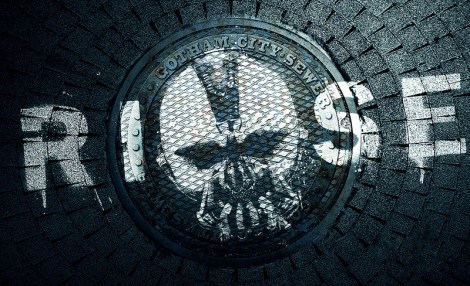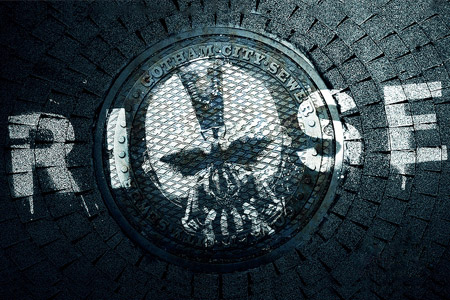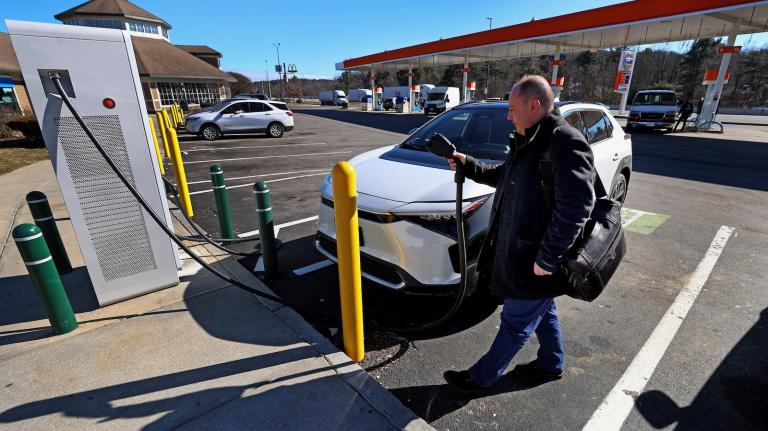
There’s a lot not to love about The Dark Knight Rises, the crazyish new chapter in the latest Batman cycle: a series of actions and explosions so unconnected that they make a Rorschach test look like a syllogism by comparison; Marion Cotillard’s death scene, which lacked only her eyes rolling up and her tongue lolling sideways from her mouth to equal those put on by toddlers on playgrounds; and Christian Bale’s Batman growl — close your eyes and you think Cookie Monster is saving Gotham City.
One thing the movie got right, though, is its focus on the infrastructure systems that serve as the beating and vulnerable heart of our urban existence. Every major plot point directly relates to the built environment and the networks that make every element of our lives possible.
In a world where almost everyone seems committed to ignoring those systems — believing that sewers maintain themselves, that roads grow free like the dandelions, that we get new communications devices free every few months like cereal box prizes — it seems perfectly reasonable and perversely satisfying that the only people who recognize their centrality to our lives are people making insane fantasy movies.
Consider: Early in the movie some bad guys take over the stock market, connecting a laptop with some kind of program to make a whole bunch of trades happen that are … well, they’re bad, that’s all I could figure out. Nobody thinks to stop the crisis by kicking the plug out of the wall, but eventually quick-thinking police do cut a fiber optic cable. Too late! The bad guys have somehow begun an up- or download of … something else bad to or from … somewhere, and as they race out of the stock exchange shooting at things, the laptop continues displaying its status bar, so we know the bad thing is still happening, presumably to the whole … thingy, not just to the laptop. I suppose whatever transfer is happening could be taking place over wifi, but I’m guessing it’s G4 — though since this movie is set in the near future I suspect maybe it’s G5 or even G6.
But the Dark Knight Rises infrastructure fest has just begun. When next we meet bad guy Bane (I can’t be the only one who imagined his name spelled “Bain,” can I?) he’s got his Gotham headquarters set up — where else but in the sewers, because sewers are intrinsically cool. Ask the Phantom of the Opera, or Jean Valjean; ask the Third Man. More, when good guy Blake goes looking for Bane, we see Blake with a sheaf of paper maps in his hand and a quizzical look on his face. The sewers are some mysterious place so preposterously tangled that nobody could easily know the way around.
Continuing on the infrastructure theme, Bane’s evil plan is to seize a fusion reactor that Bruce Wayne has mothballed because years into development it suddenly dawned on Wayne that a nuclear reactor could be used as a weapon, not just a generator (how much would you have liked to be at THAT meeting?). Bane succeeds, dragging his bomb around town for some reason in a big truck, like a toddler who won’t let go of a toy. And finally, when Bane uses the bomb to threaten the millions of Gothamites who live on a Manhattan-style island, he blows up the bridges that connect the city to the mainland. And of course when it’s time to trap virtually the entire Gotham police force, Bane lures them into the subway system, then blows barricades into the system by detonating magical exploding concrete his minions have cleverly poured in city construction sites for months.
So if you’re an infrastructure geek, you’re in heaven here, right? You’ve got data systems — wired and mobile. You’ve got energy systems. You’ve got the sewer system, the subway system, and the roads — and you’ve even got the concrete itself.
Now, that’s not to say that the treatment of these infrastructure systems makes any more sense than the rest of the movie. The thousands of cops stuck in the subway system have to be fed by lowering provisions down to them through some sort of special holes that apparently cannot fit a ladder or a rope big enough for a cop to climb. This goes on for months. As for Blake’s trouble locating Bane’s sewer lair, managers of more modern cities probably shake their heads, knowing that somewhere in their employ is a GIS worker who could have supplied Blake a map showing every pipe, junction, and manhole in the system with a few keystrokes. On the other hand, people running older cities probably nodded in recognition — records aren’t always digital or even accurate, and what’s below ground is always full of surprises.
Elsewhere in implausible land: New York has a combined sanitary and stormwater system, yet we never see Bane and his men washed away by the raging underwater flows that even a light rain causes in such systems. Hey, it’s the movies. (Speaking of such flows, this summer’s The Amazing Spiderman features a battle in the sewers between Spidey and The Lizard, in which Spiderman, washed away by just such a flow, passes downstream from an enormous pipe into one of two smaller pipes. Pipeline designers, that’s the way you design flows carrying debris, right? You take large flows and force them into smaller pipes, leaving as many barriers around for debris to begin building up and causing backups, right? Of course you do.)
OK, I’m actually not writing to complain about the infrastructure mistakes films like The Dark Knight Rises make. Anyhow, they’re nothing new — I once heard an architect ridicule The Towering Inferno for suggesting that Paul Newman’s presiding architect would have even the vaguest idea where specific system cutoffs would be.
No, I’m actually applauding, because infrastructure is finally emerging from the background and beginning to take its rightfully central place in the dramas that play out on our screens, not just in our lives. We mostly ignore it in real life; maybe the movies can remind us of its importance.
So, yes, I originally found it a little bit preposterous that, with everything in Gotham ground to a halt and the city under siege by crazy suicidal villains, somehow the water and sewer systems keep working. But upon further consideration, I found that satisfying, and even credible. Because, pretty much no matter what happens, hurricane, lightning, earthquake, or attack, the people who run our infrastructure keep it running — and where it breaks down they fix it in a hurry.


